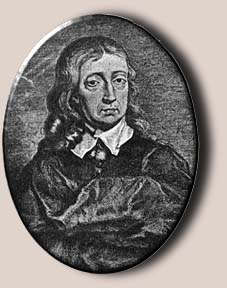TIMELINE OF ENGLISH LITERATURE - Age of Milton ( 1635- 1670)
Age of Milton
Major Historical and Literary events
1642 Civil war begins
1642 Closure of Public Theatre
1649 Charles I executed.
1653 Oliver Cromwell becomes Land Protector.
1658 Oliver Cromwell dies His son Richard succeeds.
1660 The Restoration begins (Charles II Accession)
1660 Anne Marshall, first woman on English stage.
1660 Theatre reopened.
1629 Milton’s Nativity Ode.
1631 Herbert’s Temple
1633 Milton’s L’Allegro, II Penserose.
1637 Milton’s Lycidas
1642 Thomas Browne’s Religio Medici
1644 Milton's "Areopagitica." English poet and writer John Milton publishes “Areopagita,” an essay espousing freedom of the press. Milton writes the piece in response to the censorship that is rampant in England at the time.
1659 Dryden’s The Death of Cromwell
1660 Samuel Pepys begins his diary.
 1667 Milton's "Paradise Lost." English poet John Milton completes his epic poem Paradise Lost in 1674 after becoming blind. The work, which tells the story of Lucifer’s rebellion in heaven and Adam’s fall, is an extended meditation on humanity’s relationship with God, human nature, and the meaning of life. It is considered one of the masterpieces of world literature.https://ardhendude.blogspot.in/2011/02/interview-tips-for-school-service.html
1667 Milton's "Paradise Lost." English poet John Milton completes his epic poem Paradise Lost in 1674 after becoming blind. The work, which tells the story of Lucifer’s rebellion in heaven and Adam’s fall, is an extended meditation on humanity’s relationship with God, human nature, and the meaning of life. It is considered one of the masterpieces of world literature.https://ardhendude.blogspot.in/2011/02/interview-tips-for-school-service.html
 1667 Milton's "Paradise Lost." English poet John Milton completes his epic poem Paradise Lost in 1674 after becoming blind. The work, which tells the story of Lucifer’s rebellion in heaven and Adam’s fall, is an extended meditation on humanity’s relationship with God, human nature, and the meaning of life. It is considered one of the masterpieces of world literature.
1667 Milton's "Paradise Lost." English poet John Milton completes his epic poem Paradise Lost in 1674 after becoming blind. The work, which tells the story of Lucifer’s rebellion in heaven and Adam’s fall, is an extended meditation on humanity’s relationship with God, human nature, and the meaning of life. It is considered one of the masterpieces of world literature.1678. Bunyan's "Pilgrim's Progress." English Puritan John Bunyan writes the religious allegory Pilgrim's Progress in 1678. The work, generally considered a masterpiece in Christian and English literature, describes the journey of the central character, named Christian, through life to eventual salvation.
Rulers of English Throne
1625-49Charles I
1649-60Commonwealth the Protectorate
Authors of This Era
1579-1625 John Fletcher
1593-1633 Herbert
1605-1682 Sir Thomas Browne
1608-1674 John Milton
1621-1666 Henry Vaughan
1633-1703 Samuel Pepys
1633-1703 Samuel Pepys
1.Name the two cavalier poets.
Ans. Richard Lovelace and Sir John Suckling are cavalier poets. They were cavaliers, gentleman whofought on the king’s side. There were two parties – Cavaliers and Roundheads. Cavaliers were royalists, while Roundheads were puritans and rebels against Charles I.
Lovelace – Al the from Prison.
Suckling – Ballad upon a wedding.
2.Which is the great epic by Milton and name a play by Milton?
Ans. Paradise Lost (1667) is the greatest epic of Milton. Samson Agonistes is the play by Milton.
3.Name four Cavalier poets. Why are they so called?
Ans. Lovelace, Suckling, Murrick and Carew are the four Cavalier poets. In the then England, (at the period of Charles I) there were two political parties Cavaliers and Roundheads. Cavaliers are the party of the king. These poets wrote for the king and against the Roundheads..
4.Who wrote Lycidas? What was the occasion?
Ans. John Milton wrote Lycidas. It was written in memory of a college friend of the poet, Edward king, who was drowned when his ship was wrecked on a crossing to Iceland in 1637.
5.Who are called Cavalier poets and why?
Ans. These cavalier poets are associated with the court of Charles I. They were called so as they supported the king’s party Cavalier and opposed to Roundheads, the supporter of parliament. They wrote Witty and polished lyrics of love and gallantry. The group included Richard Lovelace, John suckling, Thomas Carew and Robert Herrick.
6.Who is the author of Il Penseroso?
Ans. It is a longish poem written by Milton on the experience of gay & thoughtful man.
7.Name the play written by Milton.
Ans. Samson Agonistes (1671), a poetic play by Milton depicts the story of Samson from The Bible, book of judges. The tragedy parallels both Samson and Milton for their common suffering of blindness and heart-rending frustration.
8..How are these two years related to each other 1649 and 1660?
Ans: In 1649, the execution of Charles I is done and the Puritan government starts its rule. In 1660, the Restoration of Charles II happens and the puritanic government declines. With the Restoration there begins new lees of life in Literature contrary to puritanic restriction.
9.Who wrote Areopagitica and about what?
Ans. Areopagitica (1644) written by John Milton is a noble and impassioned plea for the liberty of the press. Here is the magnificent search for the dead truth and though egoistic here is the splendour of Miltonic prose.
10.Which book of Milton justified the beheading of king Charles? Mention his two other works.
Ans. In Tenure of Kings Milton justified the beheading of king Charles I.
His other notable works are Paradise Lost, Areopagitica, Samson Agonistes etc.
11.Give the meaning of Religio Medici?
Ans. Religio Medici (written 1635, pub 1642), a prose work by Sir Thomas Browne is his confession of faith. Here is a curious mixture of religious faith and scientific skepticism. The quoted title word means book of medicine.


Comments
Post a Comment
Drop any query, suggestion or comment here.